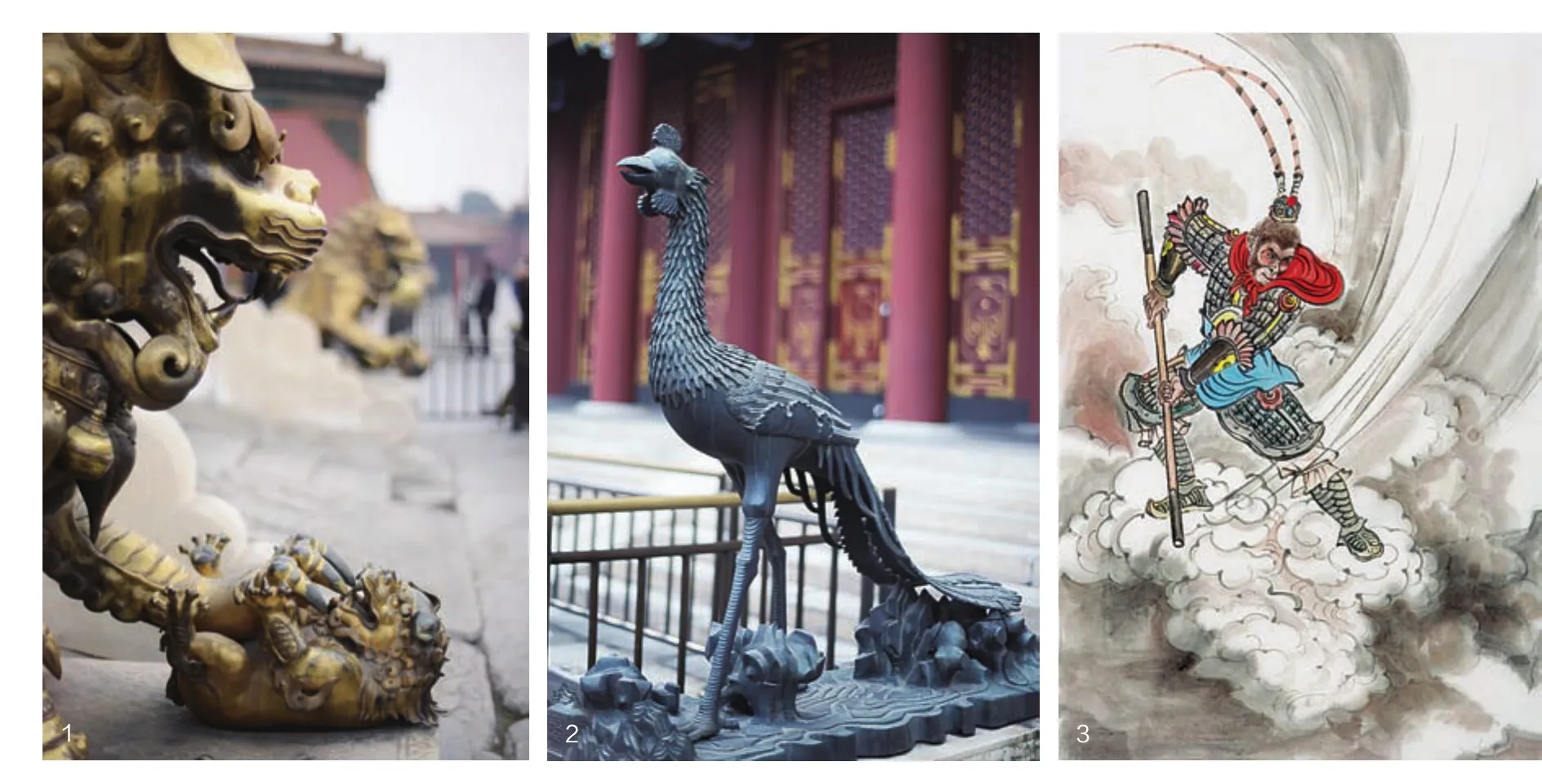East Vs West The Truth Behind Their Myths
2017-04-10SimonEdwardSmith,MadelineWeng,HaolunZhang
East Vs West The Truth Behind Their Myths
Interview by Simon Edward Smith Translation by Madeline Weng Photos by Haolun Zhang

1. Bronze gilding lioness in front of Qianqing Gate, the Forbidden City. The lioness caresses a lionet. Her hair has 13 curves, which shows supremacy and is a symbol exclusive to the imperial palace.故宫乾清门前的鎏金铜雌狮爪下躺着一小狮,表示亲昵与母爱。狮头上有鬃卷,13卷为至尊,为皇宫专用。2. Bronze feng bird in front of the Hall of Benevolence and Longevity, Summer Palace颐和园仁寿殿凤雕3. Monkey King
NIHAO: How aware is the west of Chinese mythical creatures?
S: Western scholars have long been interested in Chinese mythical creatures from a variety of viewpoints, especially those involved with the study of Chinese literature, folklore, religion, art, and archaeology. Serious research dates mostly from the 19th century onwards. The first dictionary of Chinese mythology - by an English professor - was published in the 1920s, and many more books and articles have been produced since.
However, I doubt it if the general public know of many Chinese mythical creatures apart from dragons, which usually appeared as a Chinese national symbol from decorative images on imported products and Chinese restaurants in the west. Another, perhaps, is the mythical creature Monkey King (Sun Wukong), who was first introduced to the west through an English translation of the Ming Dynasty novel Journey to the West and has recently been reintroduced through some films that have been shown abroad.
Also, the knowledge of Chinese mythical animals encounters misinterpretation and misrepresentation in the west. For instance, in English, the “feng”bird is widely mistranslated as “phoenix”, and the “foo” dog is actually based on a lion. Among a more educated reading public, academics, art collectors, and those who live in cities with Chinese populations, there is doubtless more awareness, but the degree of knowledge would be based on the kind of contact they have had with these images in each case.
NIHAO: What are the main differences
between western and Chinese mythology?
S: There are hundreds of Chinese mythical creatures, so many that encyclopaedic books like the ancient Guideways Through Mountains and Seas from 4th cent. BCE – 1st cent. CE werecompiled to identify them.
I would say that in China, mythical creatures played an important role in local culture, religious worship (Daoism, Buddhism, and local cults), literature, opera, visual art, and were also used for political purposes by the imperial government.
However, in the west, mythical creatures especially those from ancient Greece and Rome, were relegated to local folklore, subjects for artistic creativity, or used as symbolic and allegorical figures as Christianity spread. Increasingly, they were no longer regarded as real while belief in the existence of mythical creatures continued in many parts of China, and can still be found in some places today.
NIHAO: What are the main features in common between Chinese and western mythical creatures?
S: There really aren't very many common features. The western dragon is quite different from the
standard Chinese dragon, and the phoenix is also quite different from the “feng” bird.
Both cultures have traditionally believed in classes of creatures called “goblins,” “ghosts” and so forth in the west; in China these are generally referred to as “guishen” (ghosts and spirits) or as “guaiwu”(strange creatures), but these are usually conceived of different in their details. And it was thought in China that they inhabited everyplace, including dwelling secretly among people with whom they often came into confl ict.
In the west, a lot of these creatures were regarded as dwelling in forests or separate from densely populated areas. China also regarded mountains, forests, lakes, rivers, and oceans as places where such creatures dwelled, but some were also found in towns, cities, and in people's houses.
There are, however, stories of certain dragons in China that are harmful to humans and that have to be killed in order for humans to live peacefully, and this is similar to the Western dragon, which is usually an evil, menacing creature.
Also, the feng bird is an auspicious bird in China with a positive meaning when it appears (usually, that the country is well-governed), and the phoenix is also regarded as a positive symbol, though for other reasons (it rises from the ashes and represents a renewal of life). These kinds of folk beliefs have lasted longer in China than in the West.
外国人是否只认识龙?

Interviewee:
Richard E. Strassberg, Professor of Chinese specializing in premodern Chinese literature and culture at UCLA, author of A Chinese Bestiary: Strange Creatures from the Guideways through Mountains and Seas.
加州大学洛杉矶分校中文系教授,著有《山海经编引》

NIHAO:现今西方对中国神兽的理解程度如何?
S:第一本由西方教授编撰而成的中国神话字典于1920年代出版。自那以后,更多的西方学者才开始了对中国神兽的正式研究。然而,绝大部分西方人对于中国神兽的认知依然局限于中国龙和孙悟空,其接触渠道主要来源于电影、中餐馆、华人街以及中国引进产品上的图案。同时,中国神兽还面临着被西方误解的情况。比如中国“凤”通常被错译为西方传说中“phoenix”,而最常见的神兽狮子却被误译为“foo dog”。
NIHAO: 中西方神兽的主要不同在哪?
S:中国神兽影响着人民的生活习俗、戏剧文学、宗教信仰,甚至皇权统治;而西方神兽,以古希腊和古罗马为例,通常只能在地方民俗传说、语言故事和艺术作品中寻到踪影。神兽已不再影响现今西方人的生活,而在中国很大一片地区,神兽依然占据重要地位。
NIHAO: 中西方神兽是否有共通之处?
S:共同点甚少。西方的龙凤与中国的龙凤皆不一样。中国龙通常是瑞兽,只有一小部分品种对人类有害;而大部分西方龙都是邪恶的。至于凤凰,不管是在西方还是东方,都是吉兽。在中国传说中,凤凰为人民预示着繁荣昌盛;在西方,凤凰浴火重生,意味着新生。
在西方神话中,神兽/精灵通常住在森林里,远离人类。而中国神兽也一样,大部分都住在山川河流之中;然而,不同的是,部分中国神兽还会出现在城镇,甚至人们的家中。
